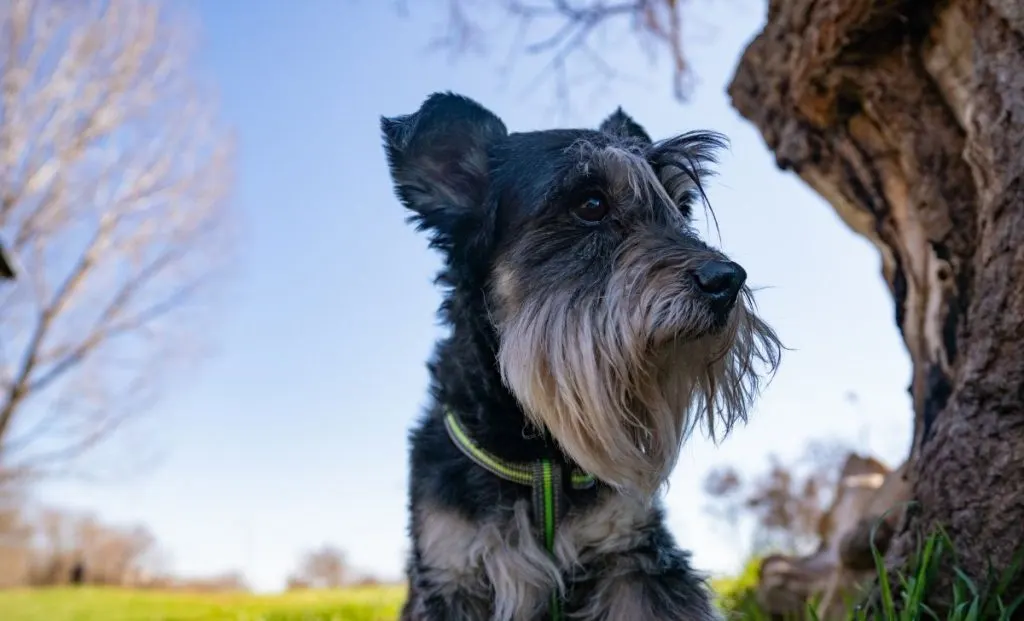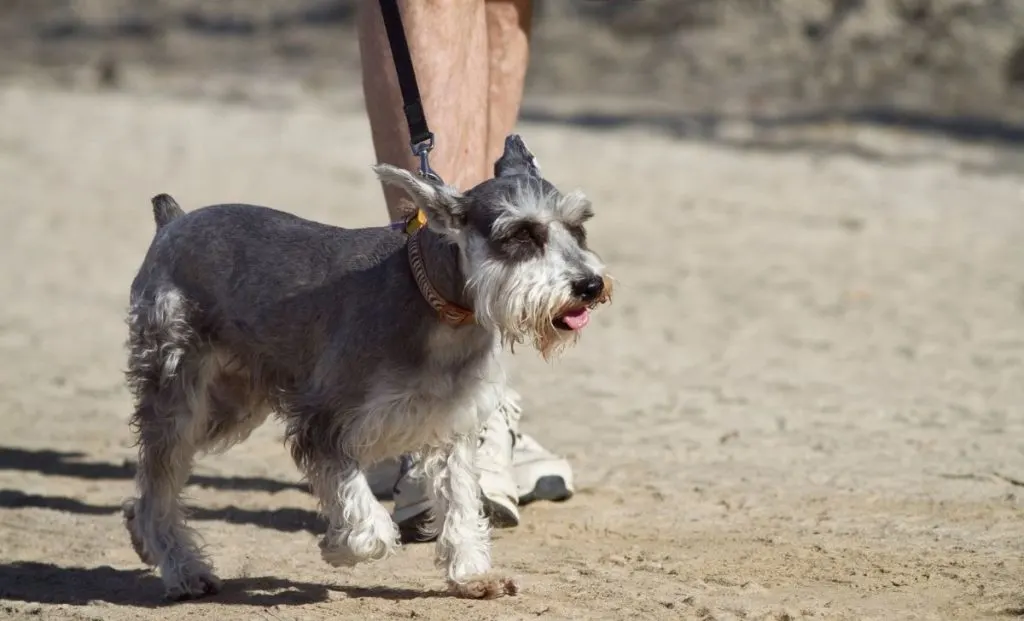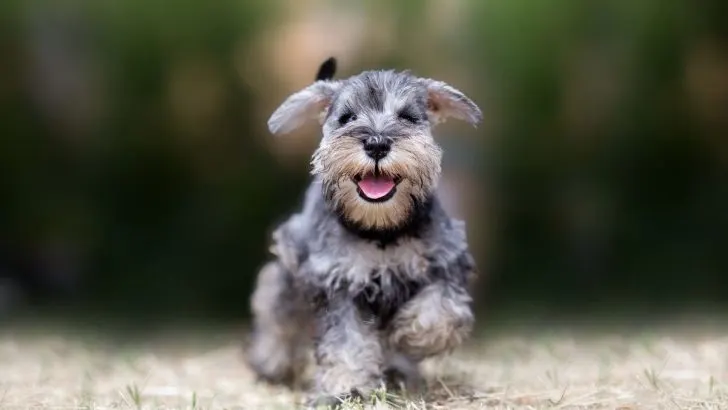I am pretty sure we are all familiar with this adorable dog breed. Miniature Schnauzers are among the most popular dog breeds in the United States.
That is no coincidence since these excellent dogs have a very extroverted personality, high activity levels, and slightly independent character.
Despite the fact that they periodically like to get their way, Miniature Schnauzers are exceptionally intelligent pups that easily win over every person who meets them at a faster rate than other breeds. Their adorable smaller size must have something to do with that.
Before choosing a Mini Schnauzer puppy to go home with you and be a new member of the family, it is essential to figure out the adult body weight and adult height of your potential pup.
The breed standard of the Mini Schnauzer dictates that they should be smaller puppies, but Schnauzers come in a medium breed and a giant breed variety as well!
In order to assist you in getting prepared for this small canine with a massive attitude, I have compiled all the important notes on the Miniature Schnauzer growth chart.
Do not worry; I included the miniature Schnauzer weight chart, all the important factors that affect its development during the important months of growth, and the details of its various developmental stages as well!
Female VS Male Miniature Schnauzer Growth Chart

Even though they are on the smaller end when it comes to size in dogs, male Miniature Schnauzers tend to be a little taller and bigger than their typical female half.
A slight chance of missing the difference at first sight exists because both genders of the Miniature Schnauzer dog look highly alike. Their differences shine through when they reach their full height and adult weight.
Nevertheless, it is general knowledge that a female miniature Schnauzer pup is usually tinier and matures sooner than her male counterpart.
This fact comes in quite handy during any type of training. However, it does not mean that females are more intelligent than males of this breed.
The differences can be noticed in personality even more than in their overall size; male Miniature Schnauzers tend to exhibit more of an aggressive demeanor towards other male dogs of any breed.
On the other hand, female Miniature Schnauzers are usually less affectionate and more independent. This can translate to the fact that the females are generally less eager to please the owners.
Male Miniature Schnauzer Size By Age
The following chart includes the standard weights and heights of a male Schnauzer dog from newborn to 2 years of age.
Please remember that these are only averages. Always consult your vet if you worry about your Schnauzer’s development.
| Age | Weight (lbs) | Weight (kg) | Height (inches) | Height (cm) |
|---|---|---|---|---|
| 0 – 1 month | 2 – 5 | 0.9 – 2.3 | 4 – 6 | 10 – 15 |
| Two months | 5 – 10 | 2.3 – 4.5 | 6 – 9 | 15 – 23 |
| Three months | 10 – 15 | 4.5 – 6.8 | 8 – 11 | 20 – 28 |
| Four months | 15 – 20 | 6.8 – 9.1 | 10 – 13 | 25 – 33 |
| Five months | 20 – 25 | 9.1 – 11.3 | 12 – 15 | 30 – 38 |
| Six months | 25 – 30 | 11.3 – 13.6 | 14 – 17 | 36 – 43 |
| 7-9 months | 30 – 35 | 13.6 – 15.9 | 16 – 18.5 | 41 – 47 |
| 10-12 months | 35 – 40 | 15.9 – 18.1 | 17.5 – 19 | 44 – 48 |
| Two years old | 35 – 45 | 15.9 – 20.4 | 18 – 20 | 46 – 51 |
This table is founded on prevailing guidelines and can differ enormously depending on individual canines.
Please always talk to your vet or the breeder for more specific and personal information about the dog in front of you.
Female Miniature Schnauzer Size By Age
The following chart includes the standard weights and heights of a female Schnauzer dog from newborn to 2 years of age.
Please remember that these are only averages. Always consult your vet if you worry about your Schnauzer’s development.
| Age | Weight (lbs) | Weight (kg) | Height (inches) | Height (cm) |
|---|---|---|---|---|
| 0 – 1 month | 1.5 – 4.5 | 0.7 – 2 | 3.5 – 5.5 | 9 – 14 |
| Two months | 4.5 – 9 | 2 – 4.1 | 5.5 – 8 | 14 – 20 |
| Three months | 9 – 14 | 4.1 – 6.4 | 7.5 – 10.5 | 19 – 27 |
| Four months | 14 – 19 | 6.4 – 8.6 | 9.5 – 12.5 | 24 – 32 |
| Five months | 19 – 24 | 8.6 – 10.9 | 11.5 – 14.5 | 29 – 37 |
| Six months | 23 – 28 | 10.4 – 12.7 | 13.5 – 16.5 | 34 – 42 |
| 7-9 months | 27 – 32 | 12.2 – 14.5 | 15 – 17.5 | 38 – 44 |
| 10-12 months | 30 – 35 | 13.6 – 15.9 | 16.5 – 18.5 | 42 – 47 |
| Two years old | 30 – 37 | 13.6 – 16.8 | 17 – 19 | 43 – 48 |
This table is founded on prevailing guidelines and can differ enormously depending on individual canines.
Please always talk to your vet or the breeder for more specific and personal information about the dog in front of you.
Growth Stages Of The Miniature Schnauzer

Miniature Snautzher pups are usually weaned at six or seven weeks but are still learning essential skills as their mom slowly leaves them more and more.
In a perfect setting, the pups must be with their littermates (or other role-model canines) for at least 12 weeks.
Pups separated from their mom and littermates too early usually don’t develop relevant “social skills,” such as understanding how to send and receive cues, what an “inhibited bite” stands for, how far to go in play wrestling and so forth.
Play is vital to help pups improve their bodily coordination, social skills, and understanding of boundaries.
Interacting with their mom and littermates enables them to comprehend “how to be a dog” and is also a route to explore ranking (or how we call it “who is in charge”).
Skills not attained during the first eight weeks may be lost forever. While these stages are essential and relatively consistent, a pup’s mind stays receptive to new experiences and lessons well after puppyhood.
Most canines are still pups, in mind and body, through the first two years of their life.
The following information provides general guidelines for the stages of development:
From 0 – 2 Weeks Old Miniature Schnauzer
A newborn miniature schnauzer is most influenced by its mother.
During this phase, the only senses the pup has developed are touch and taste.
Also during this period of their life, your puppy mainly seeks out its mother’s milk and warmth.
From 2 – 4 Weeks Old Miniature Schnauzer

From here, the care guide gets a tiny bit easier.
In this development phase, the puppy is most influenced by its mother and littermates. The fantastic tool of sight starts developing as the puppy’s eyes open, teeth start growing, and their hearing and smelling senses develop.
During this phase, your pup starts to stand, walk a little, wag its adorable tail, and even bark.
By four or five weeks of age, their sight is well-developed.
From 3 – 12 Weeks Old Miniature Schnauzer
During these essential months of age, the puppies must have opportunities to meet other dogs and people, because this is prime socialization time.
By four to six weeks, the adorable pups are most influenced by their littermates and are learning more about being a dog.
However, from four to 12 weeks, they’re most influenced by their littermates and people. This means they are learning how to play, social interactions, bite inhibition, social structure and ranking, and physical coordination.
During this time, the pups are becoming aware of their surroundings, buddies (canines and people), relationships, and play.
By five to seven weeks, puppies develop extreme curiosity and begin exploring everything they can, making it essential to provide them with positive experiences involving people during this period.
Between seven and nine weeks, they refine their physical skills and coordination, including housetraining, and gain full use of their senses.
At eight to ten weeks, puppies experience real fear and can be alarmed by ordinary objects and experiences, requiring positive training to help them cope.
From nine to twelve weeks, they refine their reactions and social skills, interact appropriately with littermates, and explore their environment, spaces, and objects while beginning to focus more on people. This is an ideal time to start formal training.
From 3 – 6 Months Old Miniature Schnauzer

During this period, they are most influenced by their littermates, though playmates can also include those of other species.
They begin to see and use ranking within the pack, displaying dominant and submissive behaviors, which extends to their interactions with humans.
As they continue to develop, they start teething and engage in associated chewing.
At four months, they undergo another fear stage.
From 6 – 18 Months Old Miniature Schnauzer
Puppies are most influenced by their human and dog “pack” members.
They go through a second chewing phase at seven to nine months to explore their territory.
During this time, they also exhibit heightened exploration of dominance, including challenging humans. If not spayed or neutered, they begin to show signs of sexual behavior.
Playmates now include those of other species, although they are still most influenced by their littermates.
FAQs About Schnauzer Puppy’s Growth And Development
1. How fast will my Schnauzer puppy grow, and how big will it get?
While Schnauzers grow most rapidly in their first six months, growth can continue until they reach about a year old. Their breed (Miniature, Standard, or Giant) significantly affects their growth rate, with each variety reaching its mature size at a different age. Miniatures typically weigh 10-15 lbs and stand 12-14 inches tall, Standard Schnauzers weigh 30-50 lbs and stand 17.5-19.5 inches tall, while the Giant type can weigh 55-85 lbs and stand 23.5-27.5 inches tall.
If you are wondering if your dog is a healthy weight, here is a tip: You should be able to feel their ribs easily without pressing hard, but you shouldn’t see them. If the waist is distinct when viewed from above and the abdomen tucks up from the side, your Schnauzer is likely at a healthy weight.
2. Is it normal for my Schnauzer puppy to have a growth spurt?
Like many breeds, Schnauzers can experience growth spurts, especially during their first six months. You might notice them becoming leggier or filling out in short periods. Growth spurts can increase your Schnauzer puppy’s appetite, so ensure they’re receiving a healthy diet and consult your vet if you have concerns about overfeeding or rapid weight or height gain.
3. How much should I feed my growing Schnauzer puppy?
Always follow the recommended serving sizes on puppy food labels, adjusting based on your puppy’s activity level. Consult with your vet about the best diet and portion sizes.
4. Do male and female Schnauzers grow at the same rate?
Generally, male Schnauzers might grow slightly faster and end up larger than their female counterparts. However, individual growth can vary.
5. When will my Schnauzer puppy get its adult coat?
By 6-8 months, your Schnauzer will start transitioning from their soft puppy coat to their rougher, denser adult coat. Regular grooming helps manage this change.
More Tips About Schnauzer Puppy Growth
Early spaying or neutering of Schnauzers can affect their growth, causing them to grow taller, so it’s important to discuss the best timing for these procedures with your veterinarian.
While most Schnauzers experience significant growth in their first year, they can continue filling out and maturing until they’re two years old, particularly in the case of Giant Schnauzers.
Ensuring your Schnauzer’s bones grow strong requires a balanced diet with appropriate calcium and phosphorus ratios, regular vet check-ups, and avoiding strenuous exercise while they’re young.
Genetics likewise play a vital role in determining your Schnauzer’s adult size, with the size of their parents and lineage being significant factors.
Moderate exercise is essential for muscle development, but excessive or high-impact exercise can harm a growing puppy’s joints.
Health issues like hypothyroidism or parasites can hinder growth, so regular vet check-ups are crucial for early detection and treatment.
Also, tiny breeds just like the toy breeds are at a greater risk of having some specific health conditions like bladder stones and urinary issues.
To Sum It All Up
Miniature Schnauzers are beloved for their extroverted personalities, high energy levels, and independence, making them one of the most popular dog breeds in the United States.
These intelligent pups quickly win over anyone they meet, and understanding their growth and development is fundamental to raising a happy and healthy pup.
From their early weeks learning social skills with their littermates to the exploration and training stages of adolescence, Miniature Schnauzers grow rapidly and need proper care to ensure strong bones and a healthy weight.
While the males of this breed tend to be slightly larger and more dominant, females mature faster and are often more independent.
Regular veterinarian check-ups, an ideal diet that meets all their nutritional needs, and moderate exercise are the most adequate tools for their development.
Each Schnauzer pup is unique, so always consult your vet for personalized advice.
Enjoy the journey with your spunky and lovable Schnauzer companion!

Nandina has been a lifelong dog owner and enthusiast. She shared her home with multiple breeds, including Giant Schnauzers, Cane Corsos, and Huskies. Currently, she is raising a three-year-old rescue and a working-line German Shepherd puppy.
Actively engaged in IGP dog sports for two years, Nandina is a certified instructor for basic obedience and socialization. She works as a trainer in her local dog sports club, and in her spare time, she handicrafts biothane gear for dogs.
